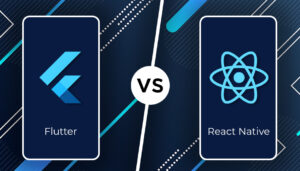
In the ever-evolving world of web development, the quest for efficient cross-platform solutions has led to the emergence of various front-end frameworks. Among these, Flutter and React stand out as two of the most popular choices. While both frameworks aim to simplify the development process and enhance performance, they take different approaches and offer distinct advantages. In this blog post, we’ll dive into the latest developments in these frameworks and compare their features, ecosystem, and use cases.
Flutter: A Comprehensive UI Toolkit
Flutter, developed by Google, is an open-source UI toolkit designed for building natively compiled applications for mobile, web, and desktop from a single codebase. It uses the Dart programming language and provides a rich set of pre-designed widgets that allow developers to create visually appealing and highly responsive interfaces.
Latest Developments:
- Flutter 2.8: The latest release focuses on performance improvements, reducing the time it takes to load Flutter apps and optimizing memory usage.
- Flutter for Web: Flutter has made significant strides in web support, enabling developers to create high-quality, interactive web applications that feel like native apps.
Key Features:
- Widget-based Architecture: Flutter’s approach to UI design is centered around widgets, which are the building blocks of the interface. This allows for a highly customizable and fast-rendering UI.
- Hot Reload: This feature enables developers to see the changes in code instantly in the app, significantly speeding up the development process.
- Single Codebase: Write once, run everywhere. This reduces the effort and time required to develop and maintain apps for multiple platforms.
React: A JavaScript Library for Building User Interfaces
React, developed by Facebook, is a JavaScript library used for building user interfaces, particularly for single-page applications. It allows developers to create reusable UI components and manage the state of the application efficiently.
Latest Developments:
- React 18: The latest version introduces features like automatic batching, which improves the performance of updates, and a new streaming server renderer for better support in Next.js.
- Concurrent Mode (Experimental): This feature allows React to render multiple states at once, improving the responsiveness of applications.
Key Features:
- Component-Based Architecture: React’s architecture is based on reusable components, which help in managing the codebase and improving maintainability.
- Virtual DOM: React uses a virtual DOM to minimize direct manipulation of the actual DOM, leading to faster and more efficient updates.
- JavaScript XML (JSX): This syntax extension makes it easy to write the UI components, which closely resembles HTML.
Comparison: Flutter vs. React
- Performance: Flutter’s widget-based approach and the ability to compile to native code generally result in better performance compared to React’s virtual DOM and JavaScript-based rendering.
- Learning Curve: React has a gentler learning curve, especially for developers already familiar with JavaScript. Flutter, using Dart, might require more time to get used to.
- Ecosystem: React has a more mature ecosystem with a vast array of libraries and tools. Flutter’s ecosystem is growing rapidly, but it’s still catching up to React’s.
- Use Cases: Flutter is ideal for developing high-performance, visually rich applications with complex animations. React is better suited for web applications and projects where leveraging existing JavaScript libraries is crucial.
Conclusion
Both Flutter and React offer compelling solutions for cross-platform development, each with its strengths and areas of best fit. Flutter’s performance and cohesive design system make it a great choice for mobile and desktop applications with demanding UI requirements. On the other hand, React’s flexibility and extensive ecosystem make it a go-to for web development and projects that can benefit from the vast JavaScript landscape.
As a developer, your choice between Flutter and React will depend on your project’s specific needs, your familiarity with the underlying languages, and the long-term goals of your application. Regardless of your choice, staying updated with the latest developments in these frameworks is key to leveraging their full potential and delivering outstanding cross-platform experiences.
